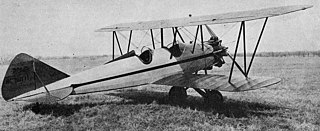
The Piper PA-38-112 Tomahawk is a two-seat, fixed tricycle gear general aviation airplane, originally designed for flight training, touring and personal use.

The Cirrus Vision SF50, also known as the Vision Jet, is a single-engine very light jet designed and produced by Cirrus Aircraft of Duluth, Minnesota, United States.

The Avro Club Cadet was a 1930s single-engined British biplane trainer aircraft, designed and built by Avro as a development of the earlier Cadet. It was planned for private and club use and, unlike the Cadet, was fitted with folding wings.

The Bellanca 14-7 Junior and its successors were a family of light aircraft manufactured in the United States by Bellanca Aircraft Corporation shortly before World War II. They were followed post-war by the Bellanca 14-13 and its derivatives.

The Miles M.2 Hawk was a twin-seat light monoplane designed and produced by the British aircraft manufacturer Miles Aircraft Limited during the 1930s. It is the first of the company's aircraft to attain quantity production.

The Commonwealth Skyranger, first produced as the Rearwin Skyranger, was the last design of Rearwin Aircraft before the company was purchased by a new owner and renamed Commonwealth Aircraft. It was a side-by-side, two-seat, high-wing taildragger.

The Harlow PJC-2 was a 1930s American four-seat cabin monoplane, designed by Max Harlow.

The Fairchild 22 Model C7 was an American two-seat touring or training monoplane designed and built by the Kreider-Reisner division of the Fairchild Aircraft Corporation at Hagerstown, Maryland.

The Great Lakes Sport Trainer is an American biplane trainer and aerobatic aircraft. It was originally produced in large numbers before the company building it went bankrupt in the Great Depression in 1933. Owing to its continuing popularity, however, it was eventually placed back into production in the 1970s and again in 2011 by WACO Classic Aircraft.

The Gee Bee Sportster was a family of sports aircraft built in the United States in the early 1930s by the Granville Brothers. They were low-wing strut- and wire-braced monoplanes of conventional, if short-coupled, design, with open cockpits and fixed, tailskid undercarriage.

The Ryan S-C (Sports-Coupe) was an American three-seat cabin monoplane designed and built by the Ryan Aeronautical Company. At least one was impressed into service with the United States Army Air Forces as the L-10.

The Westland Widgeon was a British light aircraft of the 1920s. A single-engined parasol monoplane, the Widgeon was built in small numbers before Westland abandoned production in 1929.

The Rearwin Sportster is a 1930s American two-seat, high-winged, cabin monoplane designed and built by Rearwin Aircraft & Engines for sport/touring use.

The Rearwin Cloudster was a two or three-seat civil utility aircraft produced by the Rearwin Aircraft & Engines Company of Kansas City, Missouri beginning in 1939. It was a strut-braced, high-wing monoplane of conventional design with an enclosed cabin and fixed, taildragger undercarriage. One specialized version was produced as a trainer for Pan American Airways.

The Rearwin Junior was a 1930s two-seat high-winged ultra-light monoplane sport aircraft produced in the United States by Rearwin Airplanes Inc. It was part of a trend of extremely low-cost aircraft as manufacturers attempted to survive the Great Depression.

The Waterman Arrowbile was a tailless, two-seat, single-engine, pusher configuration roadable aircraft built in the US in the late 1930s. One of the first of its kind, it flew safely but generated little customer interest, and only five were produced.

The Rearwin Ken-Royce was an American three-seat sport/touring biplane built by Rearwin Airplanes first in Salina, Kansas then Kansas City. It was the first airplane built by the company.

The Vega Model 2 Starliner was a prototype five-seat feeder airliner produced by the Vega Airplane Company, a subsidiary of Lockheed. It was designed to be powered by an unusual powerplant, consisting of two Menasco piston engines coupled together to drive a single propeller. A single example was built, flying in 1939, but no production followed.

The Ogden Osprey was a three engine, high wing monoplane airliner which seated six. Designed in the United States and first flown in the spring of 1930 or earlier, six were built and some used commercially before Ogden Aeronautical ceased trading in the Great Depression.
The Travel Air Model 10 was a 4-seat single-engined light aircraft of the late 1920s. Twelve aircraft were built before production ended.




















